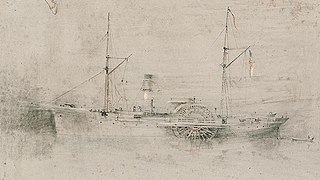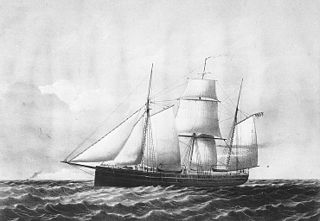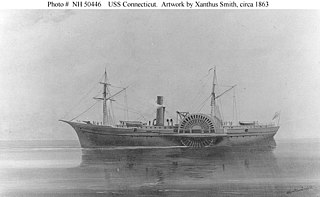
USSKeystone State was a wooden sidewheel steamer that served in the Union Navy during the American Civil War. She was a fast ship for her day and was used effectively to blockade Confederate ports on the Atlantic coast. She participated in the capture or destruction of 17 blockade runners. In addition to her military service, Keystone State had a lengthy commercial career before the war. Renamed San Francisco, she also sailed commercially after the war. The ship was built in 1853 and scrapped in 1874.

The second USS Augusta was a side-wheel steamer in the United States Navy during the American Civil War. She was named for the city of Augusta, Georgia.
The first USS Mohican was a steam sloop-of-war in the United States Navy during the American Civil War. She was named for the Mohican tribe and was the first ship of her class.

USS Stars and Stripes was a 407-ton steamer acquired by the U.S. Navy and put to use by the Union during the American Civil War.

The first USS Pocahontas, a screw steamer built at Medford, Massachusetts in 1852 as City of Boston, and purchased by the Navy at Boston, Massachusetts on 20 March 1855, was the first United States Navy ship to be named for Pocahontas, the Algonquian wife of Virginia colonist John Rolfe. She was originally commissioned as USS Despatch – the second U.S. Navy ship of that name – on 17 January 1856, with Lieutenant T. M. Crossan in command, and was recommissioned and renamed in 1860, seeing action in the American Civil War. As Pocahontas, one of her junior officers was Alfred Thayer Mahan, who would later achieve international fame as a military writer and theorist of naval power.

USS Niphon was a steam operated vessel acquired by the Union Navy during the American Civil War. She was used by the Navy to patrol navigable waterways of the Confederacy to prevent the South from trading with other countries.

USS Santiago de Cuba was a side-wheel steamship acquired by the Union Navy during the first year of the American Civil War. She was outfitted as a gunboat with powerful 20-pounder rifled guns and 32-pounder cannon and was assigned to the Union blockade of the Confederate States of America. She was notably successful in this role, capturing several blockade runners. Her last major action of the war was the assault on Fort Fisher, during which seven of her crew won the Medal of Honor.

The first USS Nereus, a screw steamer built at New York in 1863, was purchased by the Union Navy from William P. Williams on 5 October 1863; and commissioned at New York Navy Yard 19 April 1864, Commander John C. Howell in command.

USS Unadilla was a Unadilla-class gunboat built for service with the United States Navy during the American Civil War. She was the lead ship in her class.

USS Aries was an 820-ton iron screw steamer built at Sunderland, England, during 1861–1862, intended for employment as a blockade runner during the American Civil War. She was captured by Union Navy forces during the Union blockade of the Confederate States of America, and was commissioned as a Union gunboat. Aries was named for the constellation.

USS Vanderbilt was a heavy (3,360-ton) passenger steamship obtained by the Union Navy during the second year of the American Civil War and utilized as a cruiser.

USS Grand Gulf was a wooden-hulled, propeller-driven steamer acquired by the Union Navy during the American Civil War. She was effective in performing blockade duty, and captured a number of Confederate blockade runners.

USS Connecticut was a large steamer acquired by the Union Navy during the American Civil War. Her primary task was to prevent ships from penetrating the Union blockade of Southern ports.

USS Isaac Smith was a screw steamer acquired by the United States Navy during the American Civil War. She was used by the Union Navy to patrol navigable waterways of the Confederate States of America to prevent the Confederacy from trading with other countries. In 1863, she became the only warship in the American Civil War to be captured by enemy land forces. She then served in the Confederate States Navy as CSS Stono until she was wrecked.

USS Lodona was a British steamship of the same name captured by the Union Navy during the American Civil War. She had been built in England for shipowner Zachariah Pearson and attempted to break the United States' blockade of Confederate ports. USS Lodona was used by the Navy to patrol waters off those ports. After the war she returned to commercial ownership.
USS Wamsutta was a steamer constructed for service with the Union Navy during the American Civil War. She was used by the Union Navy as a gunboat in support of the Union Navy blockade of Confederate waterways.
USS State of Georgia was a large steamer with powerful guns acquired by the Union Navy during the American Civil War. State of Georgia, with her crew of 113 sailors and officers, was used by the Union Navy as a gunboat in its blockade of Confederate waterways.
USS George W. Rodgers was a schooner captured by the Union Navy during the American Civil War. She was initially intended to be used as part of the stone fleet of sunken obstructions; however, she was retained and used as a picket boat and dispatch vessel and, later, as a survey ship, concentrating her efforts in the waterways of the Confederate South.
The third USS Union was a heavy (1,114-ton) steamer with a powerful 12-inch rifled gun purchased by the United States Navy during the American Civil War.

Throughout the American Civil War, blockade runners were seagoing steam ships that were used to get through the Union blockade that extended some 3,500 miles (5,600 km) along the Atlantic and Gulf of Mexico coastlines and the lower Mississippi River. The Confederate states were largely without industrial capability and could not provide the quantity of arms and other supplies needed to fight against the industrial North. To meet this need blockade runners were built in Scotland and England and were used to import the guns, ordnance and other supplies that the Confederacy desperately needed, in exchange for cotton that the British textile industry needed greatly. To penetrate the blockade, these relatively lightweight shallow draft ships, mostly built in British shipyards and specially designed for speed, but not suited for transporting large quantities of cotton, had to cruise undetected, usually at night, through the Union blockade. The typical blockade runners were privately owned vessels often operating with a letter of marque issued by the Confederate States of America. If spotted, the blockade runners would attempt to outmaneuver or simply outrun any Union ships on blockade patrol, often successfully.















